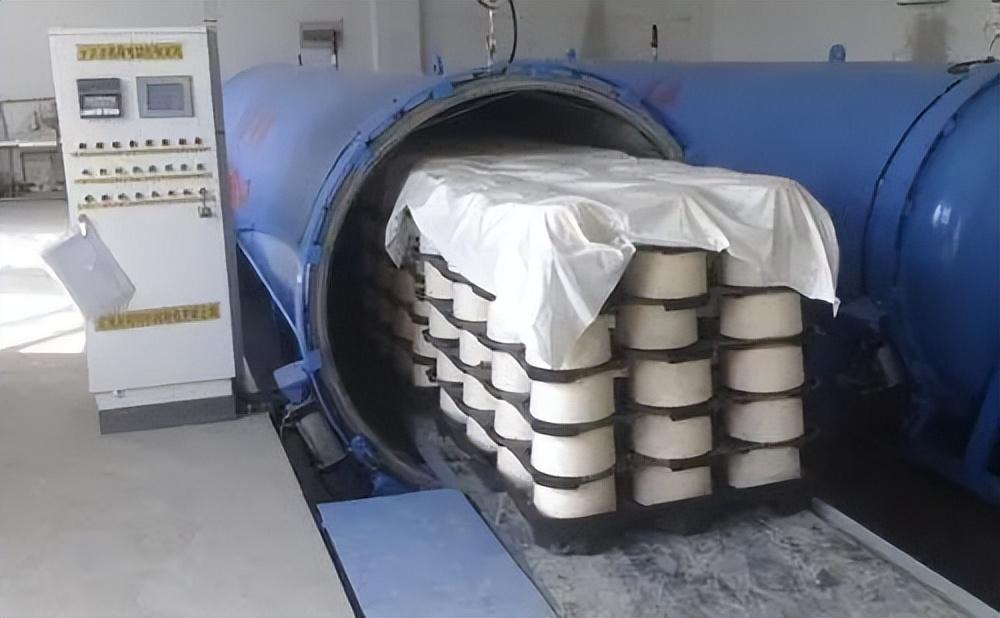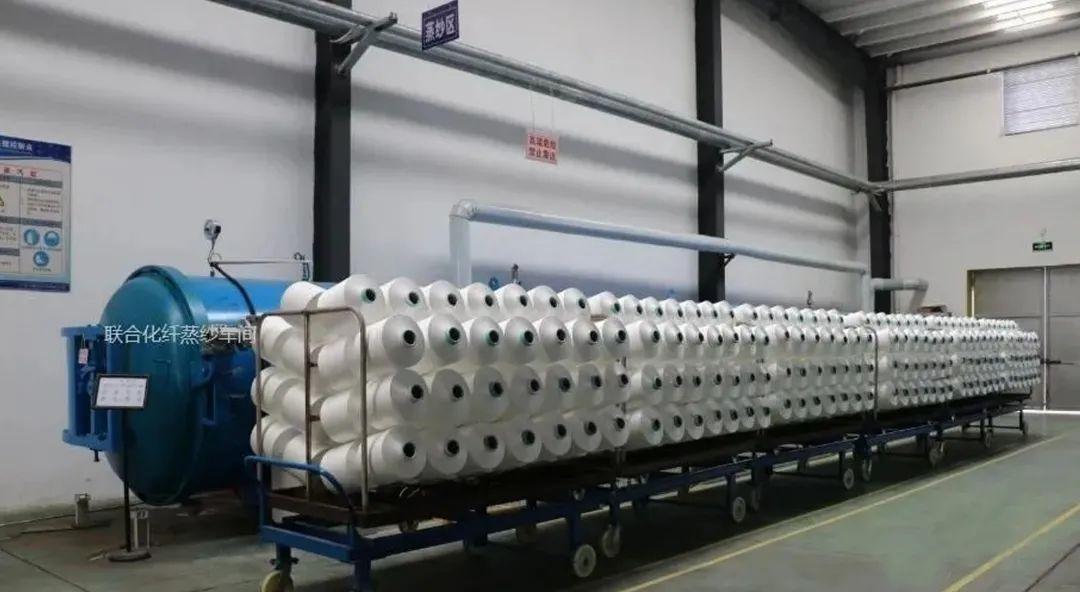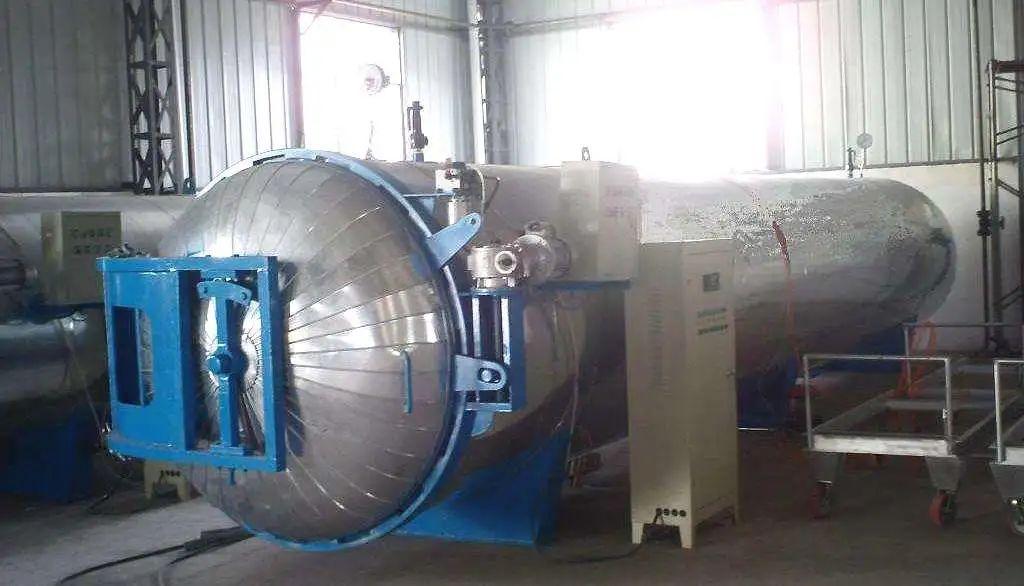
What is steamed yarn?
Steamed yarn is also called twisting. In production, hot steam is used to shape wool yarn and wool blended yarn. During the process of processing woolen raw materials into yarn, due to repeated force and friction, the internal stress is unbalanced and deformed. Fatigue and static electricity are generated; after adding twist at the same time. Wool yarn has a huge untwisting torque, which will affect the subsequent production.
A process that uses hot and humid conditions to stabilize yarn twist. After the yarn is fixed, it can prevent kinking and looping when it is relaxed, and avoid defects such as weft shrinkage in the fabric.
After twisting, the fibers in the yarn are stretched and produce internal stress that resists twisting, making the yarn twist unstable. Increasing the temperature or moisture regain can weaken the force between fiber macromolecules, relax the fiber, eliminate the internal stress that resists twisting, and achieve the purpose of stabilizing the yarn twist.
Steam Yarn Craft
Steamed yarn technology was first used in wool spinning and wool-polyester blending processes to solve problems such as fabric instability and static electricity. With the development of the textile industry, yarn steaming technology has involved cotton, linen, chemical fiber and other fields.

Steaming process
● Step one: Warm up the fuselage.
During the yarn steaming process, water drop spots on the yarn are a common problem. Water drop spots will cause dyeing and subsequent processes. other issues. Therefore, the preheating process of steamed yarn is absolutely necessary, especially for wool yarn.
● Step 2: Vacuum.
Lowers the boiling point of water in order to produce the required low temperature saturated steam.
● Step 3: Heating.
Let low-temperature saturated steam penetrate into the conical bobbin. Every production process (spinning, twisting, weaving…) will cause tension effects on yarns and fibers, and the effect of tension will cause entanglement of yarns. The stress relaxation in the molecular structure of man-made fibers causes the fibers to shrink. Tension and tangles can cause problems in subsequent processes.
● Step 4: Keep warm.
The transition from vacuum to low-temperature saturated steam allows the entire cheese including packaging materials to be completely processed. The moisture of the cold steam is transferred to the yarn, which distributes the moisture absolutely evenly, achieving consistent yarn strength and friction values. At the same time, the heat treatment also relaxes the twist.
During the yarn production process, the moisture in the fiber is constantly evaporating. From raw materials to cheese, the cumulative humidity reduction is more than 4%. . Different spinning mills have different yarn moisture indexes. Increasing the speed of the machine will cause a large loss of weight (moisture); the high temperature and friction inside the machine will evaporate the moisture in the yarn and reduce the quality of the yarn. , unfavorableThe knitting process is uniform, which reduces the efficiency of the knitting process and even causes quality problems. There are two ways to eliminate problems caused by torque. One is to rely on time and let the torque weaken naturally, but this process is long and the effect is not significant. Another way is to relax the internal stress through the yarn steaming process and twist the yarn at the same time. This method is short in time and has significant effect.
4. Other impacts
The effects of factors such as high temperature, high humidity, and high pressure improve the stability of the yarn structure and the fluffy performance. As well as the subsequent printing and dyeing process, the dyeing is more uniform and the color is brighter.
Generally speaking, the yarn steaming process improves the overall performance and quality of the fabric, making the fabric more dimensionally stable and softer and fuller to the touch. The yarn steaming process improves production efficiency, shortens delivery time, and adds advantages to enterprises in fierce competition.
The wide application of steamed yarn

- ⒈, cotton spinning
——Humidification and weight gain: increase the moisture regain rate by 1.5%-3%. - ——Stable twist: The post-twist of cotton and rayon is reduced by 40% and 60% respectively.
- ——Improve yarn quality: average yarn strength and elongation, improve the strength of weak yarns, and increase breaking elongation and breaking work by 15%.
- ——Reducing hairiness can be reduced by about 40%.
- ——Increase the quality of high count yarn, high twist yarn and other mixed carded yarn products.
- 2. Wool spinning
- ——Humidification and weight gain: increase the moisture regain rate by 1.5%-4%.
- ——Stable twist (bobbin).
- ——Reduce hairiness and improve downstream processes.
- ——Wool fiber restores elasticity and eliminates static electricity.
- ——Increase the yarn breakage limit.
- 3. Linen spinning
- ——Increased humidification: can increase the moisture regain rate by 1.5%-3%.
- ——Improve yarn quality: increase yarn strength and elongation.
- ——Soft yarn.
- 4. Silk
- — —Stable twist: Stable multi-count yarn with high twist.
- ——Silk is sensitive to humidity fluctuations, and the temperature setting is <75°C.
- 5. Man-made fibers
- ——Humidifying weight gain of viscose yarn.
- ——Heat setting and relaxing treatment of viscose yarn, high twist yarn and filament yarn.
- 6. Knitting
——Stable twist: Reduce knots and yarn entanglements, improve yarn strength, reduce downtime, and improve weaving efficiency. ——Uniform friction rate during yarn drawing: balanced and optimal friction values are always maintained from the beginning to package formation. ——No overheating: the wax will not be damaged. ——During the knitting process, the loops in the threads are evenly formed, especially suitable for pile fabrics and brushed fabrics. ——Pre-shrinking of filaments before knitting: the size of the finished product is stable. ——The yarn is soft: it reduces needle wear and improves the surface beauty of the fabric. ——Moisture regain and weight gain: no additional humidification system is required. ——Reduce flying flowers and eliminate static electricity during the production process.
- 7. Woven
——The latest necessary conditions for high-speed looms. ——Stabilize the twist, improve the strength of the yarn, reduce downtime by 10%, reduce warping yarn breakage by 15%, improve manufacturing efficiency by 2% and reduce yarn waste. ——Pre-shrunk elastic yarn to improve fabric width stability. – Reduce lint and fiber fly by 30%-45% – Fabric is softer.
- 8. Dyeing
——humidification increases weight and improves quality. ——Yarn preshrinking (spun yarn, filament, etc.). ——Pretreatment of cheese yarn before dyeing.
- 9. Underwear
——The styling of seamless underwear. ——The ribbon is subjected to moisture-conditioning treatment before weaving to make the surface feel good and shrink evenly after dyeing.
- 10. Towels
——Intensify debugging and improve production efficiency.
A3;”>——Heat setting and relaxing treatment of viscose yarn, high twist yarn and filament yarn.
- 6. Knitting
——Stable twist: reduce knots and yarn tangles, improve yarn Line strength, reducing downtime and improving weaving efficiency. – Uniform friction rate during yarn drawing: from the beginning to package formation, always maintain a balanced and optimal friction value. – No overheating: the wax will not be damaged. – —During the knitting process, the loops in the thread are uniform, especially suitable for pile fabrics and brushed fabrics. —Pre-shrinking of filaments before knitting: the size of the finished product is stable. —The yarn is soft: that is, the needle is reduced Wear and improve the surface aesthetics of the fabric. – Moisture regain and weight gain: no additional humidification system is needed. – Reduce flying flowers during the production process and eliminate static electricity.
- 7. Weaving
——The latest necessary conditions for high-speed looms .—Stabilize twist, improve yarn strength, reduce downtime by 10%, reduce warping yarn breakage by 15%, improve manufacturing efficiency by 2%, and reduce yarn waste.—Preshrunk elastic yarn, improve fabric width stability – Reduce lint and fiber flying by 30%-45% – The fabric is softer.
- 8. Dyeing
——Humidifying increases weight and improves quality. ——Yarn preshrinking (spun yarn, filament, etc.). ——Pretreatment of cheese yarn before dyeing.
- 9. Underwear
——The styling of seamless underwear. ——The ribbon is subjected to moisture-conditioning treatment before weaving to make the surface feel good and shrink evenly after dyeing.
- 10. Towels
——Intensify debugging and improve production efficiency.








